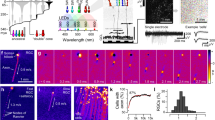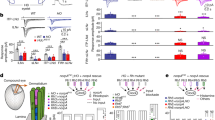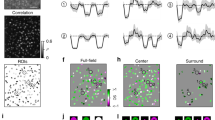Abstract
PHOTORECEPTORS are the first in the chain of neurons that process visual information. In lateral eyes of vertebrates, light hyperpolarizes rod and cone photoreceptors that synapse onto bipolar and horizontal cells in the first synaptic layer of the retina. The sign of the photoreceptor signal is either conserved or inverted in bipolar cells, resulting in chromatically dependent depolarizing and hyperpolarizing responses to visual stimuli. Visual information is then conveyed to the second synaptic layer for encoding and transmission to the brain by ganglion cells. The parietal (third) eye of lizards does not contain bipolar cells or other interneurons. Photoreceptors synapse directly onto ganglion cells1–4 and yet, even in the absence of interneurons, antagonistic chromatic mechanisms modulate the ganglion cell responses5,6. We report here that chromatic antagonism in the third eye originates in the chromatically dependent hyperpolarizing and depolarizing response of the photoreceptors to light. We also suggest that the antagonistic nature of these photoresponses may provide lizards with a mechanism for the enhanced detection of dawn and dusk.
This is a preview of subscription content, access via your institution
Access options
Subscribe to this journal
Receive 51 print issues and online access
$199.00 per year
only $3.90 per issue
Buy this article
- Purchase on Springer Link
- Instant access to full article PDF
Prices may be subject to local taxes which are calculated during checkout
Similar content being viewed by others
References
Eakin, R. M. The Third Eye (Univ. California Press, Berkeley, 1973).
Engbretson, G. A. & Anderson, K. J. Vis. Neurosci. 5, 395–404 (1990).
Jenison, G. & Nolte, J. Brain Res. 168, 615–618 (1979).
Petit, A. Z. Zellforsch. 92, 70–93 (1968).
Miller, W. H. & Wolbarsht, M. L. Science 135, 316–317 (1962).
Dodt, E. & Scherer, E. Vision Res. 8, 61–72 (1968).
Korf, H. W. & Wagner, U. Cell Tiss. Res. 219, 567–583 (1981).
Engbretson, G. A., Reiner, A. & Brecha, N. J. comp. Neurol. 198, 155–165 (1981).
Baylor, D. A. & Fuortes, M. G. F. J. Physiol. 207, 77–92 (1970).
Ahmed, J. & Engbretson, G. A. Vision Res. (in the press).
Yau, K. W. & Baylor, D. A. A. Rev. Neurosci. 12, 289–327 (1989).
Dodt, E. in Handbook of Sensory Physiology (ed. Jung, R.) 113–140 (Springer, Berlin, 1973).
Ekstrom, P. & Meissl, H. Neuroscience 25, 1061–1070 (1988).
Hamasaki, D. I. & Dodt, E. Pflugers Arch. 313, 19–29 (1969).
Pu, G. A. & Dowling, J. E. J. Neurophysiol. 46, 1018–1038 (1981).
Tabata, M., Tamura, T. & Niwa, H. Vision Res. 15, 737–740 (1975).
Eldred, W. D. & Nolte, J. Vision Res. 18, 29–32 (1978).
Minke, B., Hochstein, S. & Hillman, P. J. gen. Physiol. 62, 87–104 (1973).
Nolte, J. & Brown, J. E. J. gen. Physiol. 59, 186–200 (1972).
Hamdorf, K. & Razmjoo, S. Biophys. struct. Mech. 5, 137–161 (1979).
Porter, W. P. SOLRAD and SINE: Clear Sky Direct and Diffuse Solar Radiation for Horizontal and Sloping Surfaces and Sinusoidal Air Temperature Variation over 24 Hours (Univ. Wisconsin, Madison, 1989).
Author information
Authors and Affiliations
Rights and permissions
About this article
Cite this article
Solessio, E., Engbretson, G. Antagonistic chromatic mechanisms in photoreceptors of the parietal eye of lizards. Nature 364, 442–445 (1993). https://doi.org/10.1038/364442a0
Received:
Accepted:
Issue Date:
DOI: https://doi.org/10.1038/364442a0
This article is cited by
-
Insights into the evolutionary origin of the pineal color discrimination mechanism from the river lamprey
BMC Biology (2021)
-
Spontaneous magnetic alignment behaviour in free-living lizards
The Science of Nature (2017)
Comments
By submitting a comment you agree to abide by our Terms and Community Guidelines. If you find something abusive or that does not comply with our terms or guidelines please flag it as inappropriate.



